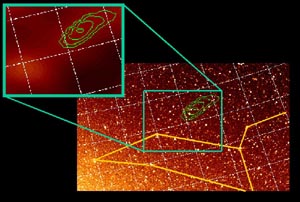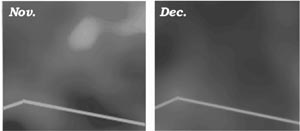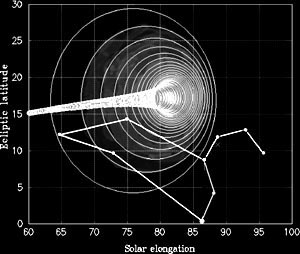|
Leonid MAC |
| home |
| View the shower |
| Mission Brief |
| Science Update |
| Media Brief |
| links |
LEONID DAILY NEWS: November 1, 2000
LEONIDS APPROACHING EARTH
Unsettling as it may sound, Leonid meteoroids are all but invisible when in the
vast expanse of space between the planets. The tiny grains are too far dispersed
and too large to scatter sunlight effectively. Until now, the only way to detect
the grains in space was from their thermal infrared emission. In this manner, many
short-period comets were found to have dust trails in their orbit.
Now, in the recent September 10 issue of the Astrophysical Journal,
Ryosuke Nakamura of Kobe University, Japan,
and his co-workers report on the discovery
of a faint glow of scattered sunlight from the dust trail of the Leonid parent comet
55P/Tempel-Tuttle. While inside the dust trail of comet 55P/Temple-Tuttle, a faint glow
was seen in the direction of approach of the particles, just above the body of the
constellation "Leo" (figure right). Such "meteoroid clouds" were known before only
from a few anecdotes of eye witnesses of past meteor storms.
The glow was first detected during the November 1998 Leonid shower, in a
conserted airborne and ground-based
effort involving the 1998 Leonid MAC mission and the Mauna Kea observatory in Hawaii. It was
not seen a month later in December,
when the Earth had moved away from the dust trail (figure below).
This detection provides a unique cross-section of the dust complex, which measures
about 0.02 AU across (2 percent of the Earth-Sun distance), and is elongated in the
comet orbital plane.
The brightness of the cloud is approximately 2-3 percent of the background
zodiacal light and represents all of Tempel-Tuttle's meteoroid complex, not just the
part of the dust trail responsbible for the 1998 Leonid shower (Full paper - PDF).
This year, the last quarter Moon will make further observations all but impossible in
the direction of approach. Southern hemisphere observers, however, may be able to
see the trail in the opposite direction on the sky, where the meteoroids move away from
Earth, in the evening hours when the Moon (and the Leonid shower) do not distract.
Figures below: The diffuse glow seen during the Leonid shower and one month later.
Left: A graph showing how the dust trail would look like as seen from Earth.
Nov. 01 - Leonids approaching Earth Oct. 31 - Prospects for Moon Impact Studies Oct. 30 - Comet dust crumbled less fine
| ||




